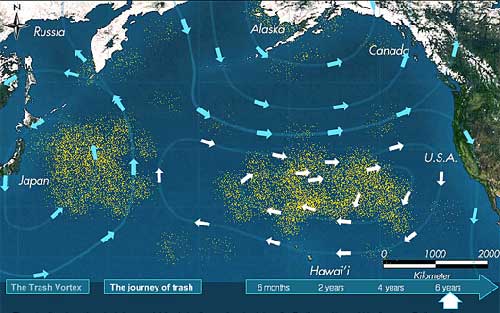 By JUSTIN BERTON San Francisco Chronicle November 01, 2007
But that might not stop the federal government from trying. Charles Moore, the marine researcher at the Algalita Marina Research Foundation in Long Beach, Calif., who has been studying and publicizing the patch for the past 10 years, said the debris -- which he estimates weighs 3 million tons and covers an area twice the size of Texas -- is made up mostly of fine plastic chips and is impossible to skim out of the ocean.  This diagram shows how trash (yellow dots) entering the sea from land along the Pacific coast is caught by the gyre. On its way the trash is concentrated and eventually ends up in one of the two shown areas. As a consequence, in these areas, the surface water contains six times moe plastic than plankton biomass (dry weight).
The trash collects in one area, known as the North Pacific Gyre, due to a clockwise trade wind that circulates along the Pacific Rim. It accumulates the same way bubbles gather at the center of hot tub, Moore said. A 2-liter plastic bottle that begins its voyage from a storm drain in San Francisco will get pulled into the gyre and take weeks to reach its place among the other debris in the Garbage Patch. While the bottle floats along, instead of biodegrading, it will "photodegrade," Moore said -- the sun's UV rays will turn the bottle brittle, much like they would crack the vinyl on a car roof. They will break down the bottle into small pieces and, in some cases, into particles as fine as dust. The Garbage Patch is not a solid island, as some people believe, Moore said. Instead, it resembles a soupy mass, interspersed with large pieces of junk such as derelict fishing nets and waterlogged tires -- "an alphabet soup," he called it. Also, it's undetectable by overhead satellite photos because it's 80 percent plastic and therefore translucent, Moore added. The plastic moves just beneath the surface, from 1 inch to depths of 300 feet, according to samples he collected on the most recent trip, he said. By Moore's estimation, the "floating landfill" is also simply too far from land to conduct any meaningful cleanup operation. It's about 1,000 miles west of California and 1,000 miles north of the Hawaiian Islands -- a week's journey by boat from the nearest port. It swirls in a convergence zone located about 30 to 40 degrees north latitude and 135 to 145 west longitude. There's no doubt that a stew of marine debris exists in the convergence zone of the gyre, said Holly Bamford, an oceanographer and director of the marine-debris program at the National Oceanic and Atmospheric Administration, but there is some debate as to its size. Moore has led most of the research and publicity surrounding the Garbage Patch, so Bamford said her federal agency, which oversees ocean conditions, is collecting its own data to assess the area and density. Bamford said she has noted some "gaps in the research" that suggest the affected area is not as large as Moore estimates. Yet there's no question that marine debris is gathering in the area and is having a negative impact on marine life, such as fish that mistake the particles for food. "But before we embark on a huge removal process," Bamford said, "we need to understand what we're dealing with." In the meantime, as the production and the use of plastic continue to grow, so will the Garbage Patch, Moore said. The only way to reduce marine debris, all sides agree, is to cut it off at its source -- on land. The dramatic growth in plastics use over the past two decades is what distresses activists like Moore. The annual production of plastic resin in the United States has roughly doubled in the past 20 years, from nearly 60 billion pounds in 1987 to an estimated 120 billion pounds in 2007, according to a study by the American Chemistry Council, which represents the nation's largest plastic and chemical manufacturers. Keith Cristman, a senior director of packaging at the American Chemistry Council, said the industry is aware of its connection to marine debris and said the council is working with federal and state agencies to put more recycling bins on California beaches in an attempt to stop plastic bottles and bags from making their way to the sea.
Distributed to subscribers for publication by Scripps Howard News Service, http://www.scrippsnews.com Publish A Letter in SitNews Read Letters/Opinions
|